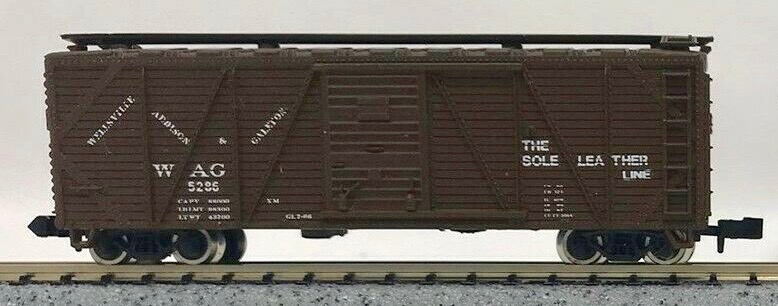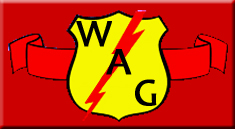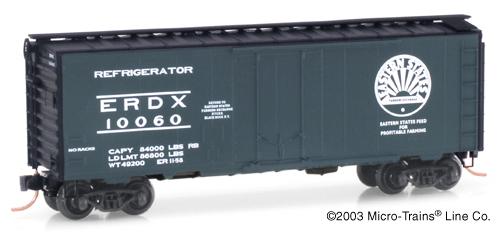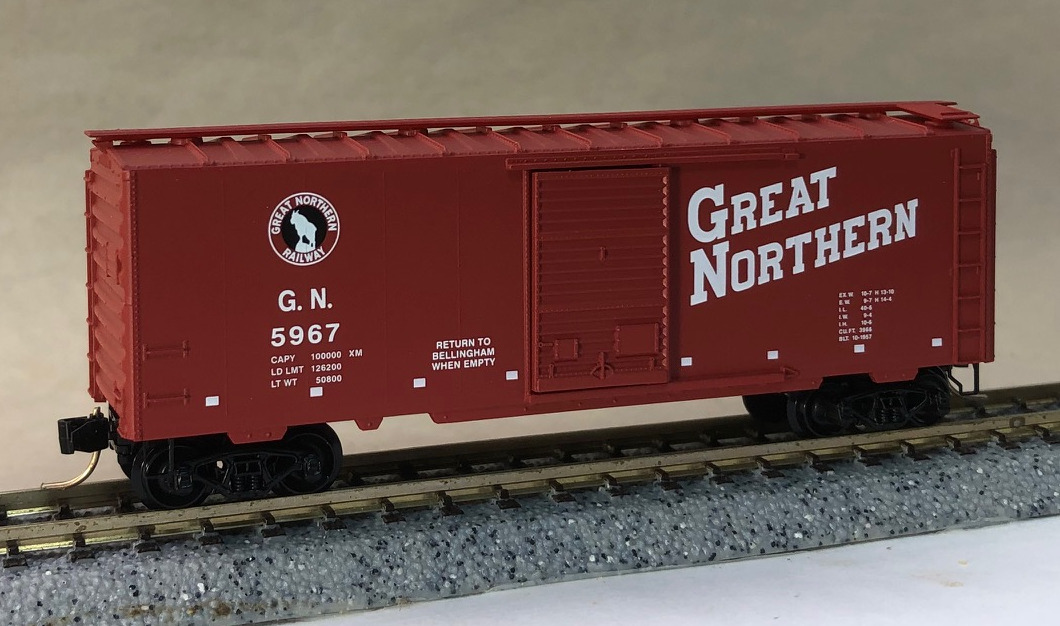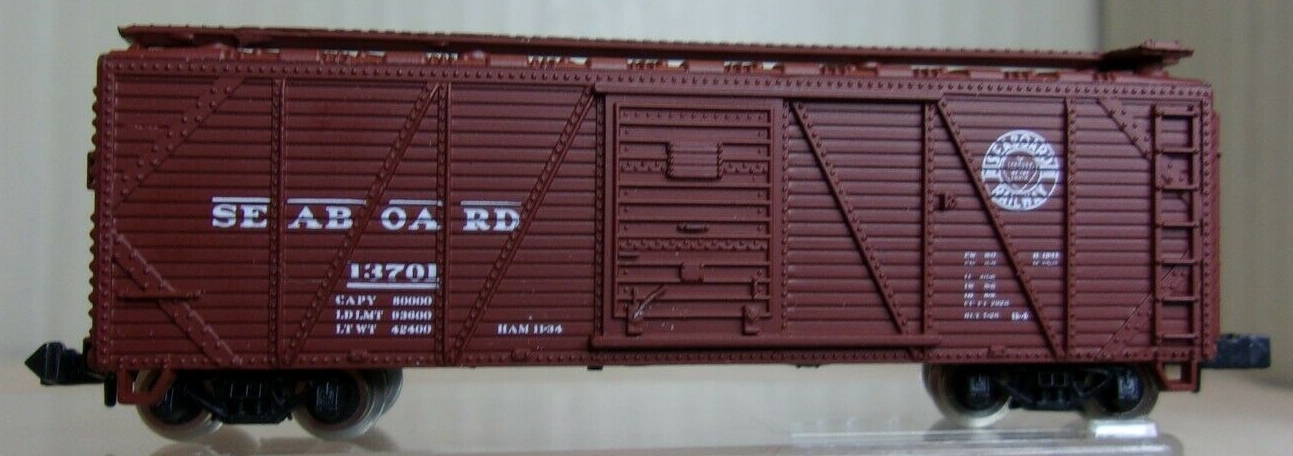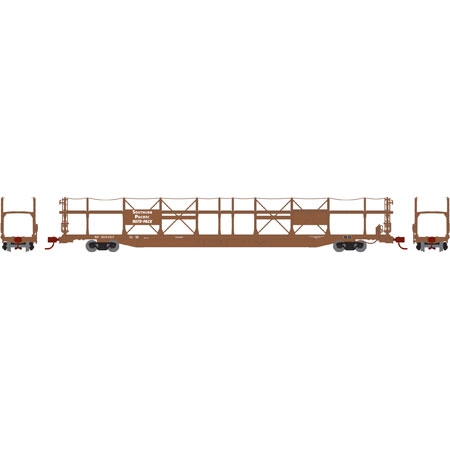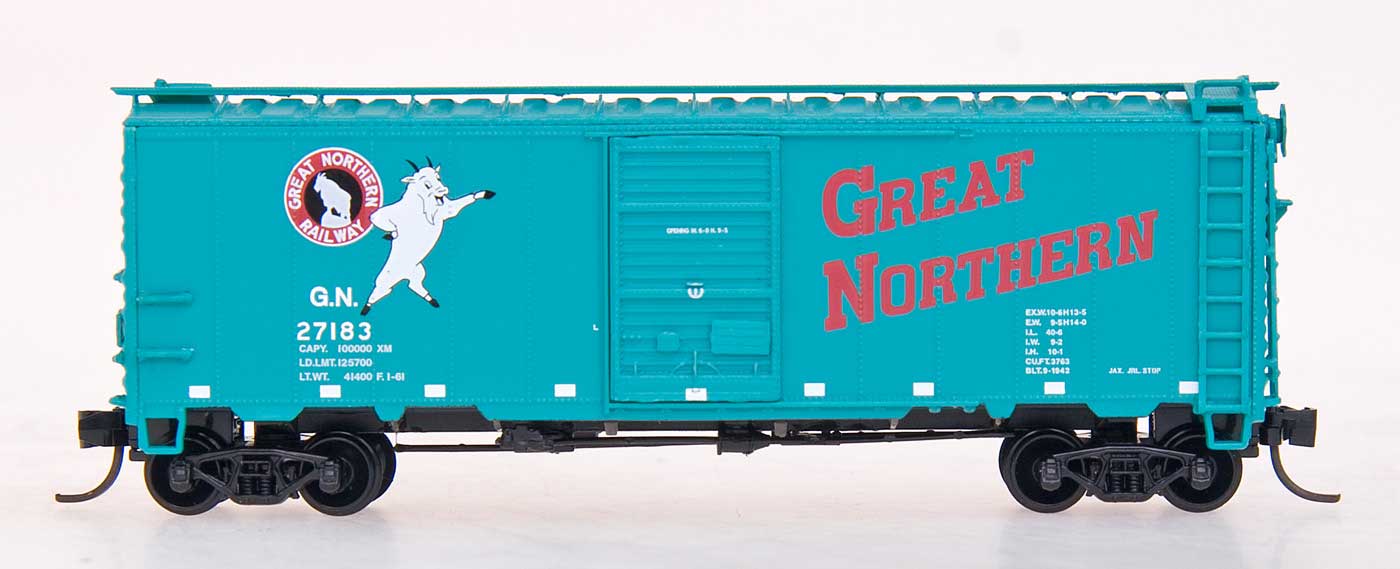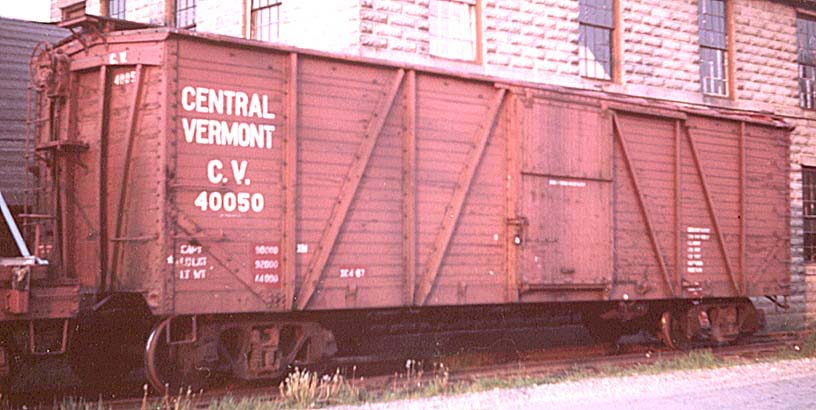Specific Item Information: Listed in the 1993 Walthers N&Z Reference Book.
Model Information: The boxcars were first produced by Roco for Aurora's Postage Stamp line of N Scale Trains. They have also been imported by Model Power until the early 1980's. They were later imported using Roco's own branding by Walthers.
Prototype History: The outside braced single sheathed box car proved to be a significant development in railway freight car technology in North America. Thousands of them saw use on North American railways beginning in the late 19th century through the 1960s. They carried bulk products such as grain and coal. They also carried packaged or bagged lading referred to as clean lading. While most of the outside braced cars were built for general service, some were built specifically to carry machinery and automobiles. For forty years freight trains on the prairies and indeed all across the country consisted of long lines of outside braced boxcars. They could commonly be found at elevators and loading platforms in communities small and large. They dominated railway yard scenes well into the 1940s.
The use of steel for the under frame (center and side sills), side and end frames initiated a new form of railway freight car building technology. Steel center sills and other under sill framing gave the cars the strength necessary to withstand the stress of longer and faster trains as well as the considerable stress involved in the contact necessary to activate closure of the knuckle coupler while being made up into trains in rail yards or from being picked up from local sidings along the line. The steel frame and the single wood side sheath minimized the weight of the car. This type of car design led to easy construction and repair. Its initial construction cost was low. The design provided secure joints between sides, ends and floors which prevented grain leakage.
The use of steel for the under frame (center and side sills), side and end frames initiated a new form of railway freight car building technology. Steel center sills and other under sill framing gave the cars the strength necessary to withstand the stress of longer and faster trains as well as the considerable stress involved in the contact necessary to activate closure of the knuckle coupler while being made up into trains in rail yards or from being picked up from local sidings along the line. The steel frame and the single wood side sheath minimized the weight of the car. This type of car design led to easy construction and repair. Its initial construction cost was low. The design provided secure joints between sides, ends and floors which prevented grain leakage.
Road Name History: The WA&G originated in 1954 by Murray Salzburg, who had made a career scrapping abandoned railroads but ultimately went on to save some he thought worthy of a second chance. Salzburg inquired with Baltimore & Ohio about buying some former Buffalo & Susquehanna lines along the Pennsylvania-New York border. In 1956, Salzburg and his new WA&G took over a V-shaped route from Galeton, Pennsylvania northwest to Wellsville, New York and from Galeton northeast to Addison, New York. A short branch from the Addison line went to Ansonia. Total length was 91 miles. The locomotive fleet was noteworthy. Operations began with seven GE 125-ton switchers that had been built in 1937 and custom styled for Ford Motor Company’s River Rouge plant in Michigan. They received the orange and cream colors that were used on Salzburg’s other shortlines.
The WA&G was located in the “leather belt” and tanneries provided much of the business. WA&G bought a modest fleet of old wood sided boxcars from Boston & Maine. These cars received WA&G name and “The Sole Leather Line” motto on their sides. Since hauling raw animal hides makes the boxcars unfit for any other service, that’s likely why Salzburg bought such old cars.
In 1959, the Addison line was cut back to Elkland after a bridge was condemned. In 1968, it became clear that the GE switchers were on their last legs so Salzburg supplemented them with a fleet of former Southern Pacific F7’s. In 1972, flooding washed out the Wellsville line. WA&G had already applied to abandon that line so no harm, no foul. WA&G was now down to 40 of the original 91 miles. The last train ran in March of 1979 and the Wellsville Addison & Galeton was abandoned.
The WA&G was located in the “leather belt” and tanneries provided much of the business. WA&G bought a modest fleet of old wood sided boxcars from Boston & Maine. These cars received WA&G name and “The Sole Leather Line” motto on their sides. Since hauling raw animal hides makes the boxcars unfit for any other service, that’s likely why Salzburg bought such old cars.
In 1959, the Addison line was cut back to Elkland after a bridge was condemned. In 1968, it became clear that the GE switchers were on their last legs so Salzburg supplemented them with a fleet of former Southern Pacific F7’s. In 1972, flooding washed out the Wellsville line. WA&G had already applied to abandon that line so no harm, no foul. WA&G was now down to 40 of the original 91 miles. The last train ran in March of 1979 and the Wellsville Addison & Galeton was abandoned.
Manufacturer Information:  The company was founded in 1960 by Ing. Heinz Rössler and started with a plastic Minitanks series of military vehicles. After export to the USA became successful, the model line was expanded with model trains in HO scale and the smaller N scale. TT scale was also subsequently added to the product line. The model rail product line covers many European countries including Germany, Belgium, Luxembourg, France, Spain, Austria, Italy, Switzerland, Sweden and the Netherlands, and also the USA.
The company was founded in 1960 by Ing. Heinz Rössler and started with a plastic Minitanks series of military vehicles. After export to the USA became successful, the model line was expanded with model trains in HO scale and the smaller N scale. TT scale was also subsequently added to the product line. The model rail product line covers many European countries including Germany, Belgium, Luxembourg, France, Spain, Austria, Italy, Switzerland, Sweden and the Netherlands, and also the USA.
On July 15, 2005 ROCO Modellspielwaren GmbH was declared bankrupt. From July 25 the company continues as Modelleisenbahn GmbH, but still uses the Roco brand and associated logo. On October 1, 2007, distribution of the 'Minitank' product series was assigned to the German model car manufacturer Herpa.
Since February 2008 Modelleisenbahn also owns Fleischmann, which like Roco had gone bankrupt. The two companies continue as separate brands under Modelleisenbahn GmbH, while benefiting from economies of scale through joined development projects, marketing and procurement.
From Wikipedia

On July 15, 2005 ROCO Modellspielwaren GmbH was declared bankrupt. From July 25 the company continues as Modelleisenbahn GmbH, but still uses the Roco brand and associated logo. On October 1, 2007, distribution of the 'Minitank' product series was assigned to the German model car manufacturer Herpa.
Since February 2008 Modelleisenbahn also owns Fleischmann, which like Roco had gone bankrupt. The two companies continue as separate brands under Modelleisenbahn GmbH, while benefiting from economies of scale through joined development projects, marketing and procurement.
From Wikipedia
Item created by: gdm on 2017-02-03 12:35:17. Last edited by CNW400 on 2020-07-16 14:06:21
If you see errors or missing data in this entry, please feel free to log in and edit it. Anyone with a Gmail account can log in instantly.
If you see errors or missing data in this entry, please feel free to log in and edit it. Anyone with a Gmail account can log in instantly.


